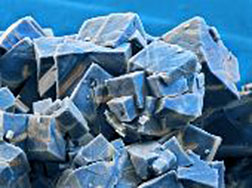- Number 428 |
- December 8, 2014
Innovation to advance natural gas fueled vehicles

Metal organic framework.
As part of his 2014 State of the Union Address, President Barack Obama called for improved use of natural gas in transportation and industry. The President called for an Energy Security Trust Fund to finance research and development for advanced vehicle technologies that focuses on shifting our cars and trucks off oil and promotes vehicles that run on electricity, hydrogen and domestically produced natural gas.
Scientists at the Department of Energy’s Savannah River National Laboratory are doing their part to help promote this effort.
Cars fueled by natural gas are not a new concept, but the challenge exists over finding a cost-effective, low-pressure storage system that can be refueled at a gas pump, similar to today’s vehicles. Researchers at SRNL are working with a special material for use in gas storage tanks, using innovation to address concerns over both cost and safety.
Gasses take up much more room under normal conditions than liquids, and thus must be stored at either high pressures or cold temperatures to reduce their volume. Metal oxide frameworks (MOFs) are a material that can be used to help lower these pressures by limiting volumes. “Current natural gas vehicles utilize either Liquefied Natural Gas at temperatures below -260 degrees Fahrenheit, or Compressed Natural Gas at pressures up to 3,600 psi,” said SRNL researcher Dr. Donald Anton. “The use of metal oxide framework material will allow the storage of the same amount of gas at 450 psi in a comparable volume. The lower operating pressure results in lighter, less expensive tanks.”
The lower pressures are possible through adsorption, in which gas molecules loosely adhere in a very dense manner to the surfaces of material. The gas molecules can be retrieved by applying heat from the engine. SRNL is also designing innovative vehicle systems that integrate the engine and the cooling system with the natural gas storage tank.
“A provisional patent has been granted for this unique design, which uses both the heat generated from the internal combustion engine, as well as the cooling capacity of the air conditioning system to control that tank’s internal temperature. This should yield performance similar to a gasoline vehicle in both driving and refueling,” Anton said.
Researchers have also developed analytical models which accurately describe the temperatures and pressures within a typical natural gas tank during operation. “These models are used to design efficient and inexpensive concepts that meet the demanding requirements of the automotive customer. By using experimental data developed by our partners, these models can help determine which characteristics are most needed in creating metal organic framework materials to help the system operate more efficiently,” he said.
The work has its origins in SRNL’s expertise in hydrogen research for the U.S. nuclear defense program. SRNL’s partners include Ford Motor Company, the University of California-Berkeley and BASF.Submitted by DOE’s Savannah River National Laboratory
